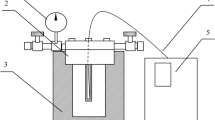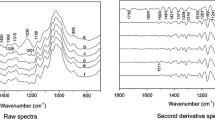Abstract
Wood was rapidly liquefied at the supercritical temperature of phenol. Under these conditions, wood was liquefied by over 90% for 0.5 min, and the combined phenol content of the obtained liquefied wood reached about 75%. The effects of various reaction conditions on liquefaction were investigated. With increases in reaction temperature, phenol/wood weight ratio, and the charged mass-to-reactor capacity (w/v) ratio, the amount of methanol-insoluble residue decreased and combined phenol content increased. The range of molecular weights and polydispersity of the products obtained after the time at which sufficient liquefaction was achieved were from 400 to 600 and from 1.5 to 2.5, respectively. Wood showed a marked decomposition to low molecular weight components early in the reaction, and then the molecular weight increased slightly with increasing reaction time. The properties of liquefied wood were investigated and compared with those obtained with conventional liquefaction methods. Combined phenol content was similar to that obtained by other liquefaction methods, except the sulfuric acid–catalyzed method, which resulted in flow properties comparable to those of other liquefaction methods. The flexural strength of moldings prepared using liquefied wood was also comparable to those prepared by other liquefaction methods.






Similar content being viewed by others
References
Adschiri T, Hirose S, Malaluan R, Arai K (1993) Noncatalytic conversion of cellulose in supercritical and subcritical water. J Chem Eng Jpn 26:676–680
Alma MH, Yoshioka M, Yao Y, Shiraishi N (1995a) Some characterizations of hydrochloric acid catalyzed phenolated wood-based materials. Mokuzai Gakkaishi 41:741–748
Alma MH, Yoshioka M, Yao Y, Shiraishi N (1995b) Preparation of oxalic acid-catalyzed resinified phenolated wood and its characterization. Mokuzai Gakkaishi 41:1122–1131
Alma MH, Yoshioka M, Yao Y, Shiraishi N (1996) The preparation and flow properties of HCL-catalyzed phenolated wood and its blend with commercial Novolak resin. Holzforschung 50:85–90
Alma MH, Yoshioka M, Yao Y, Shiraishi N (1998) Preparation of sulfuric acid-catalyzed phenolated wood resin. Wood Sci Technol 32:297–308
Arai K (1995) Biomass conversion in supercritical water for chemical recycle. Energy Resources 16:175–180 (in Japanese)
Kabyemela BM, Takigawa M, Adschiri T, Malaluan RM, Arai K (1997) Mechanism and kinetics of cellulose decomposition in sub- and supercritical water. In: Proc 4th international symposium on supercritical fluids, Sendai, Japan, 11–14 May 1997
Lee HH, Peart TE (1992) Supercritical carbon dioxide extraction of resin and fatty acids from sediments at pulp mill sites. J Chromatogr A 594:309–315
Lee SH, Yoshioka M, Shiraishi N (2000a) Preparation and properties of phenolated corn bran (CB)/phenol/formaldehyde co-condensed resin. J Appl Polym Sci 77:2901–2907
Lee SH, Yoshioka M, Shiraishi N (2000b) Liquefaction and product identification of corn bran (CB) in phenol. J Appl Polym Sci 78:311–318
Lee SH, Teramoto Y, Shiraishi N (2002a) Acid-catalyzed liquefaction of waste paper in the presence of phenol and its application to Novolak-type phenolic resin. J Appl Polym Sci 83:1473–1481
Lee SH, Teramoto Y, Shiraishi N (2002b) Resol-type phenolic resin from liquefied phenolated wood and its application to phenolic foam. J Appl Polym Sci 84:468–472
Lin L, Yoshioka M, Yao Y, Shiraishi N (1994) Liquefaction of wood in the presence of phenol using phosphoric acid as a catalyst and the flow properties of the liquefied wood. J Appl Polym Sci 52:1629–1636
Lin L, Yao Y, Yoshioka M, Shiraishi N (1997a) Liquefaction mechanism of lignin in the presence of phenol at elevated temperature without catalysts: studies on β–O-4 lignin model compound. 1. Structural characterization of the reaction products. Holzforschung 51:316–324
Lin L, Yao Y, Yoshioka M, Shiraishi N (1997b) Liquefaction mechanism of lignin in the presence of phenol at elevated temperature without catalysts: studies on β–O-4 lignin model compound. 2. Reaction pathway. Holzforschung 51:325–332
Lin L, Yao Y, Yoshioka M, Shiraishi N (1997c) Liquefaction mechanism of lignin in the presence of phenol at elevated temperature without catalysts: studies on β–O-4 lignin model compound. 3. Multi-condensation. Holzforschung 51:333–337
Lin L, Yao Y, Yoshioka M, Shiraishi N (1997d) Molecular weights and molecular weight distributions of liquefied wood obtained by acid-catalyzed phenolysis. J Appl Polym Sci 64:351–357
Martino CJ, Savage PE (1997) Supercritical water oxidation kinetics, products, and pathways for CH3- and CHO-substituted phenols. Ind Eng Chem Res 36:1391–1400
Ono H, Yamada T, Hatano Y, Motohashi KJ (1996) Adhesives from water paper by means of phenolation. J Adhes 59:135–145
Pu S, Shiraishi N (1993a) Liquefaction of wood without a catalyst. 1. Time course of wood liquefaction with phenols and effects of wood/phenol ratios. Mokuzai Gakkaishi 39:446–452
Pu S, Shiraishi N (1993b) Liquefaction of wood without a catalyst. 2. Weight loss by gasification during wood liquefaction, and effects of temperature and water. Mokuzai Gakkaishi 39:453–458
Pu S, Shiraishi N (1993c) Liquefaction of wood without a catalyst. 4. Effect of additives, such as acid, salt, and neutral organic solvent. Mokuzai Gakkaishi 40:824–829
Sasaki M, Kabyemela B, Adschiri T, Malaluan R (1997) Cellulose hydrolysis in supercritical water. In: Proc 4th international symposium on supercritical fluids, Sendai, Japan, 11–14 May 1997
Takahashi K, Sato Y, Kato K, Nishi S (1999) Decomposition of aromatic polyamide using supercritical water. Polym Prepr (Jpn) 48:3288–3289
Yalpani M (1993) Supercritical fluids: puissant media for the modification of polymers and biopolymers. Polymer 34:1102–1105
Yamada T, Ono H, Ohara S, Yamaguchi A (1996) Characterization of the products resulting from direct liquefaction of cellulose. 1. Identification of intermediates and the relevant mechanism in direct phenol liquefaction of cellulose in the presence of water. Mokuzai Gakkaishi 42:1098–1104
Yuan H, Olesik SV (1997) Supercritical fluid and enhanced-fluidity liquid extraction of phenolics from river sediment. J Chromatogr A 764:265–277
Acknowledgement
The authors wish to express their appreciation to Nobuo Shiraishi and Akira Kimura, emeritus professors of Kyoto University, Japan, for their critical reading of and comments on this manuscript.
Author information
Authors and Affiliations
Corresponding author
Rights and permissions
About this article
Cite this article
Lee, S.H., Ohkita, T. Rapid wood liquefaction by supercritical phenol. Wood Sci Technol 37, 29–38 (2003). https://doi.org/10.1007/s00226-003-0167-7
Received:
Published:
Issue Date:
DOI: https://doi.org/10.1007/s00226-003-0167-7




